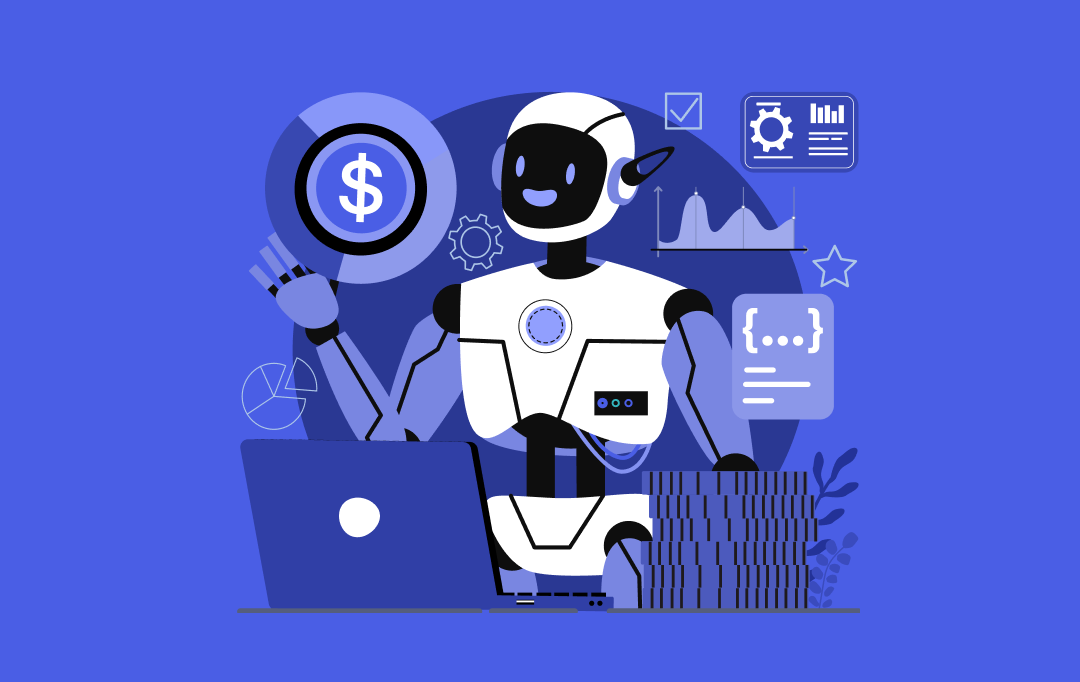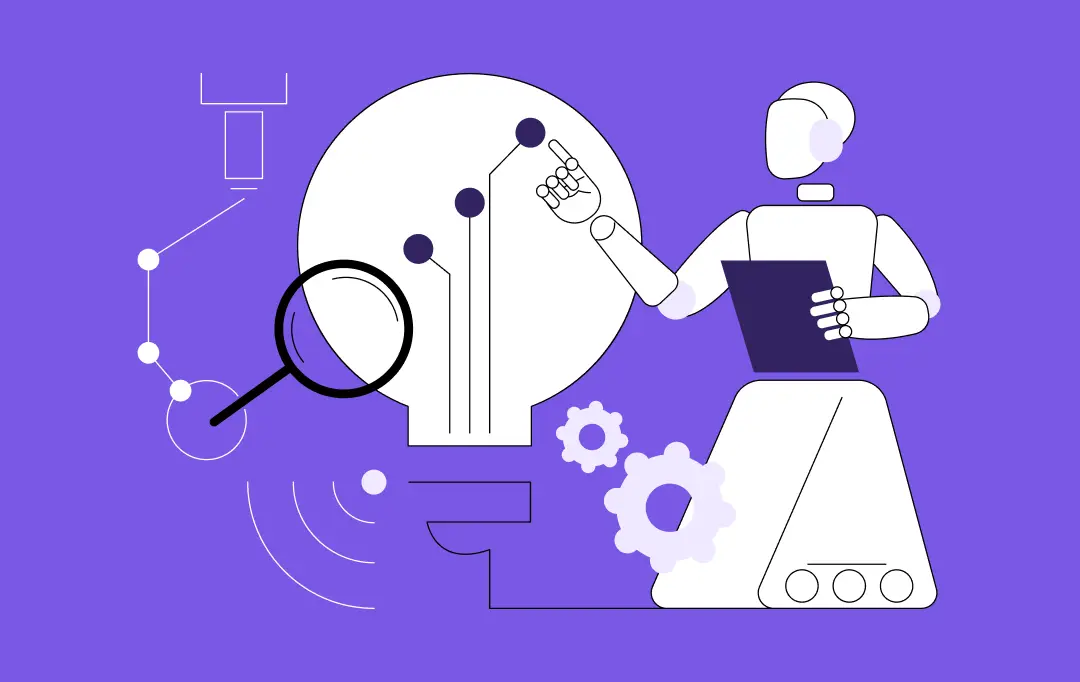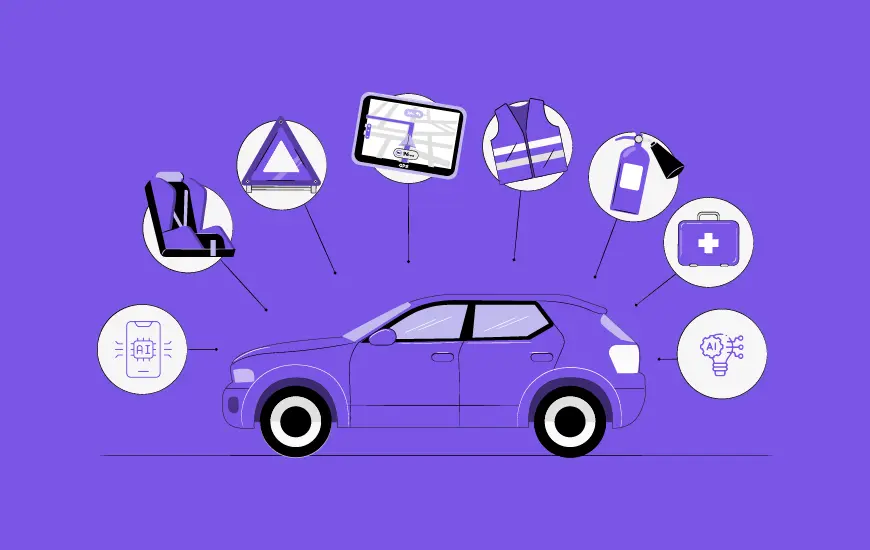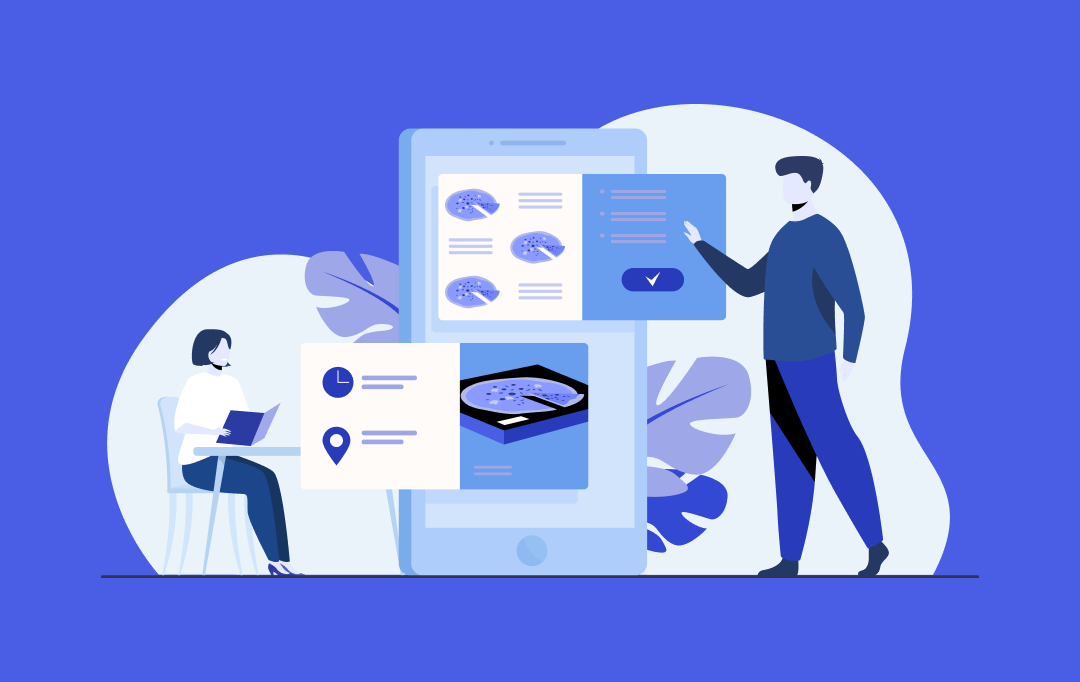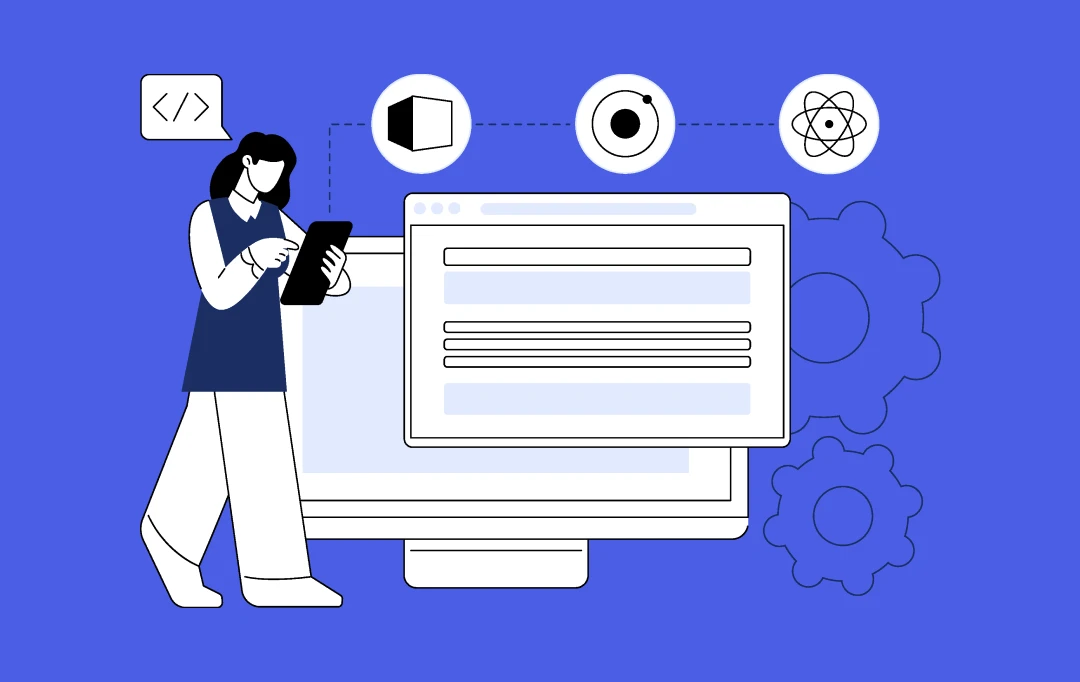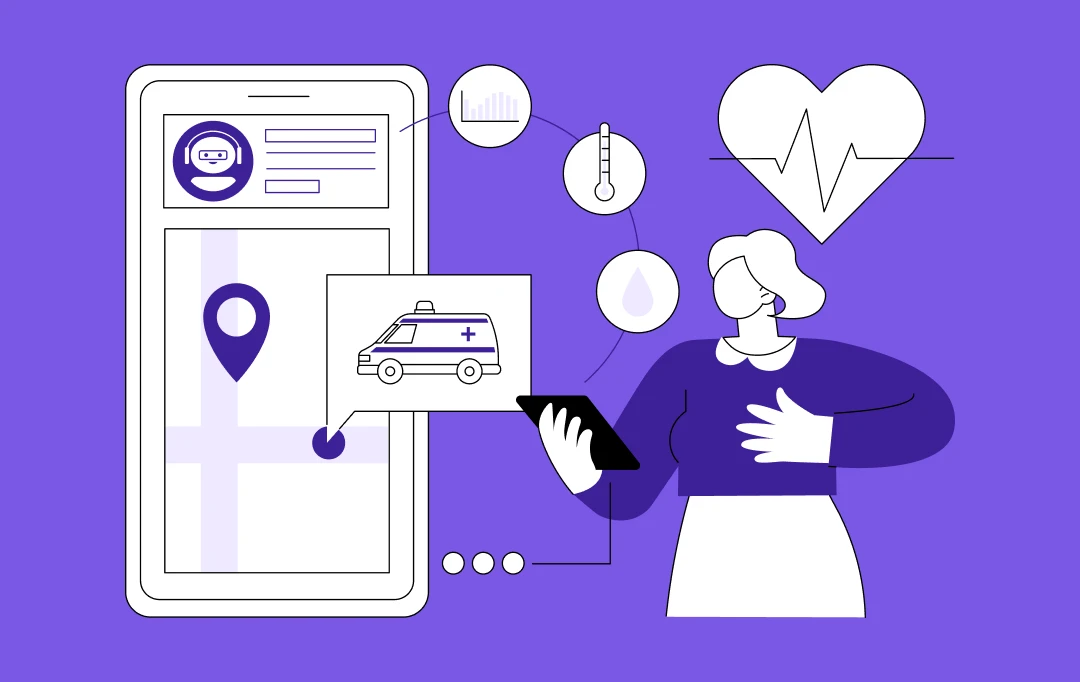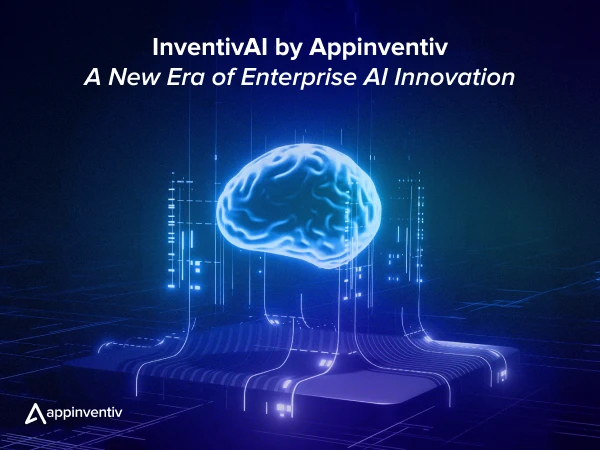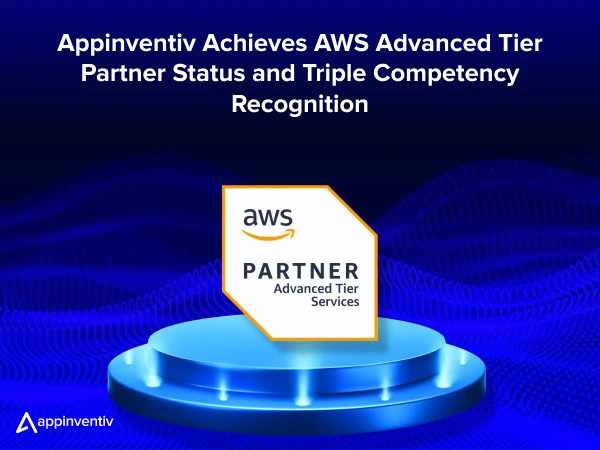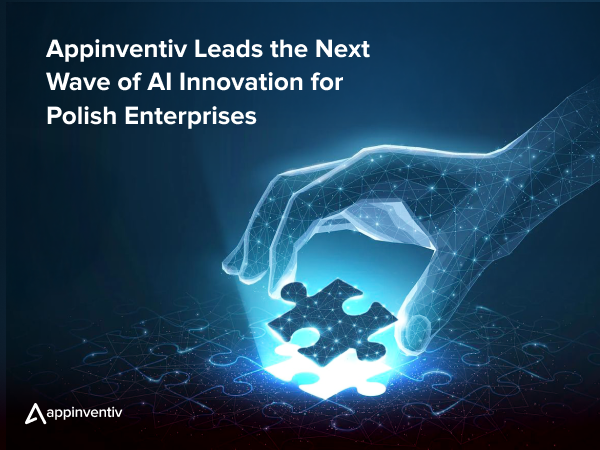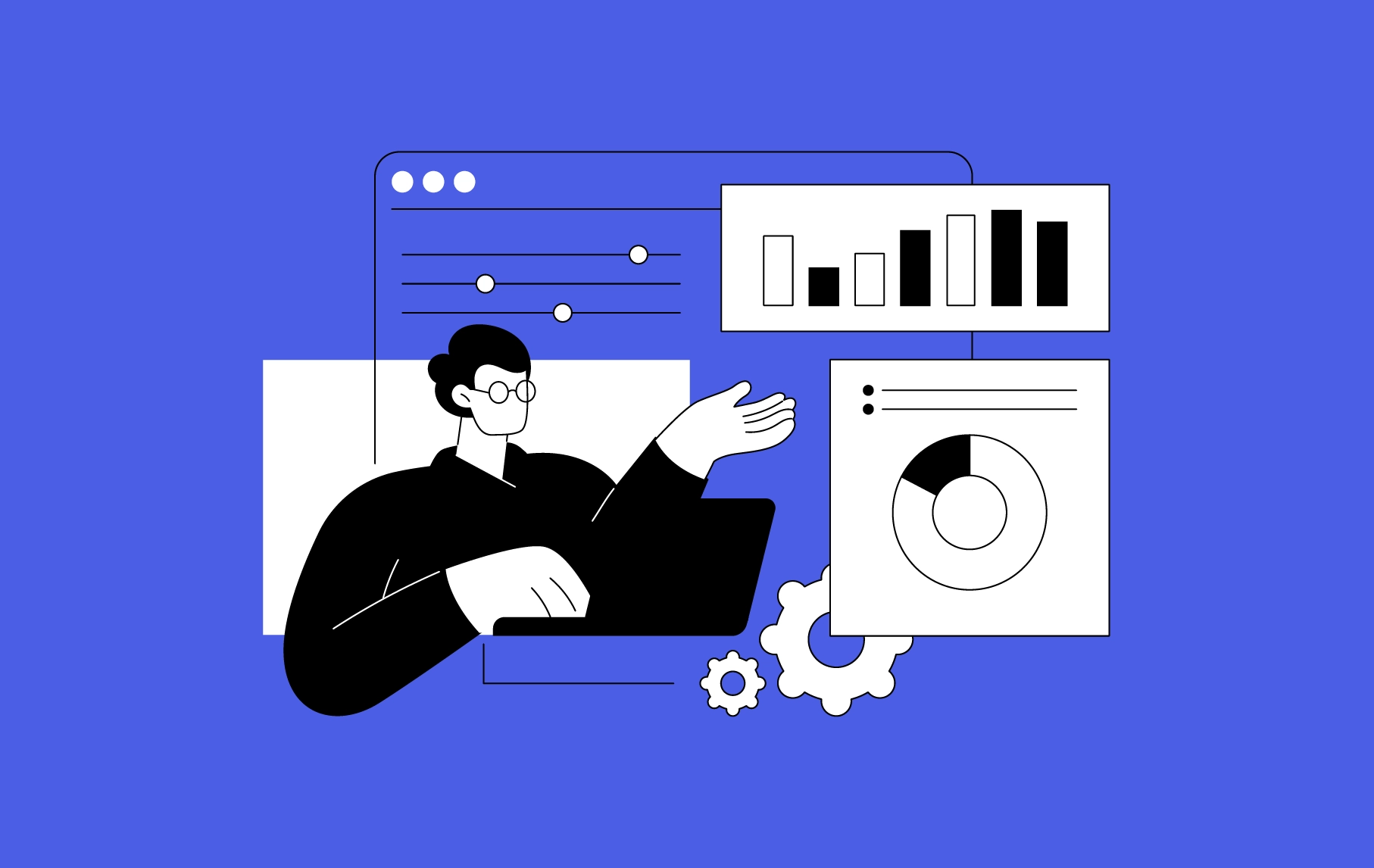- Understanding the Core Components of AI Applications
- Core Components of AI
- Benefits of Building an AI App for Businesses
- Intellectual Property Creation
- Control Over Data
- Adaptability and Agility
- Cost Efficiency in the Long Run
- Enhanced Security Measures
- Future-Proofing the Business
- Industry-Wise Use Cases of an AI Application
- Healthcare — Predictive Analytics for Patient Care
- Transportation — Autonomous Vehicles
- Real Estate — Property Valuation and Market Analysis
- Retail — Personalized Shopping Experiences
- Finance — Budget Management
- Manufacturing — Predictive Maintenance
- AI Application Development Process: A Step-by-Step Guide
- Identify the Problem and Define Business Objectives
- Choose the Right Use Case and AI Model
- Select a Scalable Tech Stack
- Collect and Prepare High-Quality Data
- Train, Validate, and Optimize the AI Model
- Design an Intuitive and Explainable UI/UX
- Integrate the AI Model into the App Backend
- Test the AI App Thoroughly
- Deploy and Maintain the AI App
- Game-Changing Features of an AI App
- Personalized Recommendation
- Chatbots and Voice Assistants
- Auto-Correction and Completion
- Predictive Analytics
- Health Monitoring
- Visual Search
- Language Translation
- Gesture Recognition
- Facial Recognition
- Image and Sticker Generation
- Text to Video Creation
- Sentiment Analysis
- Security and Compliance
- Real-Time Data Processing
- Context-Aware Notifications
- Dynamic Pricing
- Fraud Detection and Risk Scoring
- Intelligent Search
- Behavior-Based Personalization
- Offline AI Capabilities
- Adaptive Learning Flows
- Voice Biometrics
- AI-Driven Content Moderation
- How Much Does It Cost to Build an AI App?
- Factors Affecting the Cost to Build an AI App
- Understanding Monetization Models for AI Applications
- Future Trends in AI Application Development
- AI and IoT Convergence
- Enhanced Personalization Through Deep Learning
- Generative AI Embedded into Product Workflows
- Explainable AI and Regulatory-Ready Systems
- Edge AI for Low-Latency Enterprise Use Cases
- Rise of Autonomous AI Agents
- No-Code and Low-Code AI Application Development
- Human-AI Collaboration at the Core of UX
- RAG (Retrieval-Augmented Generation) for Real-Time Accuracy
- Quantum AI on the Horizon
- AI for ESG and Sustainability Intelligence
- Overcoming Challenges in AI App Development: Strategic Insights for Enterprises
- Integration with Existing Systems
- Ethical and Privacy Concerns
- Skill Gap and Talent Acquisition
- Cost of Implementation
- Managing Expectations
- Algorithmic Bias and Fairness
- Scaling AI Solutions
- Technology Obsolescence
- Data Collection, Privacy, and Model Training Challenges in AI App Development
- The Data Dilemma in Enterprise AI Projects
- The Cold Start Problem in Custom AI Application Development
- Model Training Complexities and Infrastructure Costs
- Strategic Approaches for Enterprises
- How to Measure the ROI of Your AI App
- Reduction in Manual Effort
- Increase in Revenue or Conversions
- Improvement in Accuracy or Efficiency
- Customer Satisfaction and Retention
- Faster Decision-Making
- Operational Cost Reduction
- Enhanced Scalability
- FAQs
Key takeaways:
- AI application development enables automation, personalization, and smart decision-making.
- Key stages include problem definition, model selection, tech stack setup, data prep, and deployment.
- AI app costs range from $30,000 to $300,000+, depending on complexity and features.
- Must-have features include predictive analytics, chatbots, dynamic pricing, and offline AI.
- Trends like edge AI, RAG, and autonomous agents are reshaping enterprise AI strategies.
- Measuring ROI involves tracking efficiency gains, revenue uplift, and model performance.
Picture this: Your operations are weighed down by manual decision-making, unpredictable outcomes, and slow response times. You’re drowning in data—but it’s not working for you. That friction? It’s the silent killer of efficiency, and executives everywhere are waking up to one reality: AI is the remedy—but only if you build it right.
In today’s hyper-competitive landscape, AI isn’t just buzz—it’s the engine powering smarter supply chains, proactive customer experiences, and autonomous diagnostics. And the numbers speak for themselves. According to McKinsey’s recent “State of AI” survey, 78% of organizations now use AI in at least one business function, up from 55% just two years ago. Better yet, 71% actively deploy generative AI across functions like marketing, engineering, and operations.
That’s just the start. McKinsey also estimates that generative AI could boost the global economy by $2.6 to $4.4 trillion each year. It may also increase the overall impact of AI by 15% to 40%. In industries like technology, media, and telecom (TMT), gen AI is expected to create major value—ranging from $380 billion to $690 billion. This includes $60–100 billion in telecom, $80–130 billion in media, and $240–460 billion in high-tech sectors. In fact, within the next three years, anything not using AI could be seen as outdated or ineffective. Meanwhile, Gartner predicts that by 2028, 33% of enterprise software apps will include autonomous AI agents—up from less than 1% today.
What does all this signal? Enterprises are no longer dabbling in AI—they’re embedding it into the fabric of their digital strategy, reshaping industries through AI application development tailored to real business needs.
Enter AI apps—purpose-built, mission-driven, and scalable. Whether it’s an intelligent risk analyzer that preempts financial exposure, a CV-powered quality checker on the production line, or a chatbot that feels genuinely customer-first, AI apps offer real business impact—not just dashboards.
So, if you’re wondering “How do I build an AI app that’s both enterprise-grade and outcome-driven?”, you’re in the right place. In this AI app development guide, we’ll walk you through:
- The step-by-step blueprint to develop robust AI applications
- Essential features that distinguish a powerful AI app from a proof-of-concept
- Realistic cost ranges, balancing quality and ROI
- Market trends and emerging tech—what’s now, what’s next
Let’s start building AI apps that aren’t just smart—but business-smart.
Partner with us to develop an AI app that actually solves real problems.
Understanding the Core Components of AI Applications
AI, in its most basic form, refers to the emulation of human intelligence in machines, allowing them to think and learn like humans. Thus, building AI applications involves creating a computer program capable of performing a multitude of tasks that typically require human intelligence. Reasoning, understanding natural language, analyzing sentiments, learning from experience, detecting anomalies, recognizing patterns, and making decisions are some of the most notable tasks performed by AI apps.
To gain an in-depth understanding of how to create an artificial intelligence app, it is crucial to understand the core components of artificial intelligence and their notable applications in various scenarios.
Core Components of AI
AI is a multifaceted field that encompasses various components and elements. Understanding the working mechanism of these components will give you a clear picture of how to build a custom AI application and how they will work. Here are the different integral elements of AI:

Machine Learning (ML)
Machine Learning is a core component of AI that allows systems to learn from data and enhance their performance over time without explicit programming. It involves algorithms that can analyze and interpret complex data patterns to make predictions or decisions. Its working mechanism includes:
- Supervised Learning: Learning from labeled data to make predictions, such as detecting spam emails.
- Unsupervised Learning: Identifying patterns in unlabeled data. It is used for clustering and association tasks, such as customer segmentation.
- Reinforcement Learning: Interacting with an environment and receiving feedback in the form of rewards or penalties. It is commonly used in robotics and game AI.

Neural Networks
Neural networks, a branch of AI inspired by neurology, simulate the human brain by mimicking its vast network of neurons. In a simple term, neural networks are computational models that combine cognitive science with machines to perform tasks like recognizing patterns and making decisions. Its working mechanism includes:
- Artificial Neural Networks (ANNs): Basic neural networks used for simple pattern recognition tasks, such as image and speech recognition.
- Convolutional Neural Networks (CNNs): Specialized for processing grid-like data such as images and videos, essential in facial recognition and self-driving cars.
- Recurrent Neural Networks (RNNs): Designed to handle sequential data, used in applications like language modeling and time-series forecasting.
Deep Learning
Deep Learning is basically a subset of machine learning that uses neural networks with many layers (deep neural networks). It excels in learning from large amounts of unstructured data. Its working mechanism includes:
- Speech Recognition: Transcribing spoken language into text with high accuracy.
- Image and Video Processing: Enhancing and recognizing patterns in visual content.
- Natural Language Understanding: Improving the accuracy of NLP tasks such as translation and sentiment analysis.
Also Read: Cost of developing an AI Voice and TTS app like Speechify
Natural Language Processing (NLP)
NLP facilitates the interaction between computers and humans in natural language. It enables machines to understand, interpret, and generate human language. Its working mechanism includes:
- Text Analysis: Extracting meaningful information from text data, such as identifying customer sentiment from reviews.
- Machine Translation: Automatically translating text from one language to another, such as Google Translate.
- Speech Recognition: Converting spoken language into text, used in intelligent voice assistants like Siri, Alexa, and Tootle.

Computer Vision
Computer Vision enables machines to interpret and make decisions based on visual inputs from the world. It involves image processing and pattern recognition technologies to understand and analyze images and videos. Its working mechanism includes:
- Image Recognition: Identifying objects, individuals, and scenes in images, such as tagging photos on social media.
- Object Detection: Locating and identifying multiple objects within an image as seen in autonomous vehicles and security surveillance.
- Image Segmentation: Computer vision in healthcare helps in dividing an image into segments for easier analysis. This aids in advanced medical imaging and object recognition.
Robotics
Robotics combines AI with mechanical engineering to create machines capable of performing tasks autonomously or semi-autonomously with minimal human intervention. These robots can be used in manufacturing, healthcare, agriculture, and logistics to improve efficiency and accuracy. Its working mechanism includes:
- Robotic Process Automation (RPA): Automating repetitive tasks in business processes like data entry and customer service.
- Autonomous Robots: Robots that can perform tasks without human intervention, such as AI drones and robotic vacuum cleaners.
- Collaborative Robots (Cobots): Robots designed to work alongside humans in environments like manufacturing and healthcare.
Expert Systems
Expert systems emulate the decision-making abilities of a human expert. They use a combination of knowledge and rules to solve specific problems in fields such as medical diagnosis, financial forecasting, and customer support. Its working mechanism includes:
- Knowledge Base: Containing a repository of specialized information, facts, and rules about a particular domain, such as a medical database for diagnosis.
- Inference Engine: Applying logical rules to the knowledge base to draw conclusions or make decisions.
- User Interface: Allowing users to interact with the system, input data and receive guidance or solutions.
Fuzzy Logic
Fuzzy Logic is a method of reasoning that deals with approximate rather than fixed and exact reasoning. It is used in systems that need to make decisions based on imprecise or uncertain information. Its working mechanism includes:
- Control Systems: Managing complex systems like climate control in buildings.
- Pattern Recognition: Identifying patterns in data where traditional binary logic falls short.
Understanding these elements of AI provides a comprehensive view of how AI systems function, how various technologies are used to perform multiple tasks, and, most importantly, how to build an AI app that exceeds expectations.
Benefits of Building an AI App for Businesses
AI application development can benefit businesses looking to innovate and streamline their operations. These applications enhance efficiency and provide significant competitive advantages in today’s fast-paced market environment.

Intellectual Property Creation
Building an AI app can contribute to a company’s intellectual property assets, providing long-term value. Owning the IP gives a competitive edge and opens up additional revenue streams such as licensing or selling the technology.
Control Over Data
By developing an AI app, businesses maintain complete control over their data ecosystems. This control is crucial for complying with data protection regulations and utilizing proprietary data without compromising security or privacy.
Adaptability and Agility
Having your own AI app enables quicker adaptations to changes in the business environment or market. This agility ensures businesses can respond to emerging trends or operational challenges more effectively.
Cost Efficiency in the Long Run
While the initial development cost might be high, owning an AI app can lead to significant cost savings over time by automating tasks, optimizing resources, and reducing reliance on third-party software solutions.
Enhanced Security Measures
Custom AI apps can be designed with advanced security features tailored to the specific risks faced by the business. This can provide stronger protection of business data and operations than off-the-shelf software might offer. When comparing custom AI vs off-the-shelf AI solutions, the security gap is often the biggest deciding factor. Companies in regulated industries especially find that custom AI vs off-the-shelf AI solutions deliver far greater control over data access, storage, and compliance.
Future-Proofing the Business
Investing in AI app development prepares businesses for the future. As AI technology evolves, having a dedicated AI app allows for seamless integration of new functionalities and technologies, keeping the company at the forefront of innovation. For instance, if you wish to launch an AI-powered dating app that continuously refines match suggestions based on user behavior, or develop a smart personal finance app that analyzes spending patterns in real-time and offers tailored insights, an AI-first approach enables constant evolution. This ensures your business remains adaptable, competitive, and ready to embrace emerging trends as they shape the market.
Industry-Wise Use Cases of an AI Application
The applications of AI in businesses are innumerable and invaluable. Whatever you imagine, AI can achieve it. Here are some compelling applications and examples of AI across various industries, showcasing how this cutting-edge technology is driving efficiency and fostering innovation.

Healthcare — Predictive Analytics for Patient Care
AI applications in healthcare are revolutionizing patient care by enabling predictive analytics that forecast patient outcomes and improve care management. These systems analyze vast amounts of data to predict disease progression and suggest personalized treatment plans. Additionally, AI-powered diagnostic tools analyze medical images to detect diseases like cancer at an early stage.

Example: Health at Scale uses predictive analytics to enhance patient care by forecasting potential health issues before they arise. It helps healthcare providers proactively manage chronic conditions and tailor preventive care strategies, resulting in more personalized and effective treatment plans.
Transportation — Autonomous Vehicles
AI is at the core of developing autonomous vehicles, enabling them to navigate and drive safely on the road without human intervention. These self-driving vehicles use computer vision, machine learning, automotive analytics, and sensor data to make decisions and operate efficiently.
Example: Waymo uses AI in its range of self-driving cars to interpret sensor data, recognize objects, and make driving decisions, demonstrating the potential of AI in transforming transportation.
Also Read: AI in Transportation: Benefits, Use Cases, and Examples
Real Estate — Property Valuation and Market Analysis
AI enhances real estate by providing accurate property valuations and market analysis, helping buyers, sellers, and real estate professionals make informed decisions. AI apps analyze data from multiple sources, including historical sales, property features, and market trends, to estimate the right property price and forecast real estate trends.
Example: HouseEazy, a real estate platform built by Appinventiv, leverages AI to offer precise property valuations and market insights. By analyzing vast amounts of real estate data, including property attributes and market dynamics, HouseEazy provides users with accurate home valuations and investment recommendations, helping them make informed decisions.
Retail — Personalized Shopping Experiences
AI in the retail and eCommerce industry uses AI to create personalized shopping experiences for customers. AI in eCommerce apps like Target, Walmart, Amazon, etc. analyzes users’ browsing behavior, purchase history, and preferences to recommend products tailored to their tastes.
Example: Amazon’s recommendation engine uses AI to suggest products based on users’ browsing and purchase history, increasing customer engagement and driving sales.
If you’re exploring use of AI in retail/eCommerce, understanding the fundamentals of AI-powered marketplace app development can help you design platforms that match buyers and sellers intelligently, offer dynamic pricing, and build trust at scale.
Finance — Budget Management
AI in finance plays a pivotal role in offering personalized financial advice and detecting fraudulent activities by analyzing transaction patterns and identifying anomalies in real-time. Additionally, AI application development helps transform budget management by automating tasks such as budgeting, expense tracking, and investment analysis, helping users make informed decisions.
Example: Mudra partnered with Appinventiv to build a budget management app that uses AI to help millennials manage their finances efficiently. By analyzing spending patterns and financial behavior, Mudra keeps tabs on the users’ expenses and provides personalized budgeting advice, helping users set savings goals.

Manufacturing — Predictive Maintenance
AI in manufacturing uses predictive maintenance to anticipate equipment failures and schedule timely repairs. This is one of the most integral use cases of an AI app in manufacturing that helps minimize downtime and maintenance costs.
Example: General Electric (GE) uses AI in its Predix platform to predict when industrial machinery needs maintenance. By analyzing sensor data and operational metrics, Predix helps manufacturers maintain equipment efficiency and avoid costly breakdowns.
The range of roles AI applications can play in business is vast and continually expanding. In simple terms, anything a human can do, AI apps or Physical AI apps can do better and faster—and in many cases, they already surpass human capabilities.
AI Application Development Process: A Step-by-Step Guide
Building AI applications is a complex and challenging process requiring advanced technologies such as deep learning, machine learning, natural language processing (NLP), data science, computer vision, robotics, and more.
However, the below step-by-step guide to building an AI app can help you transform your innovative concept into a robust, real-world application that drives transformative results.
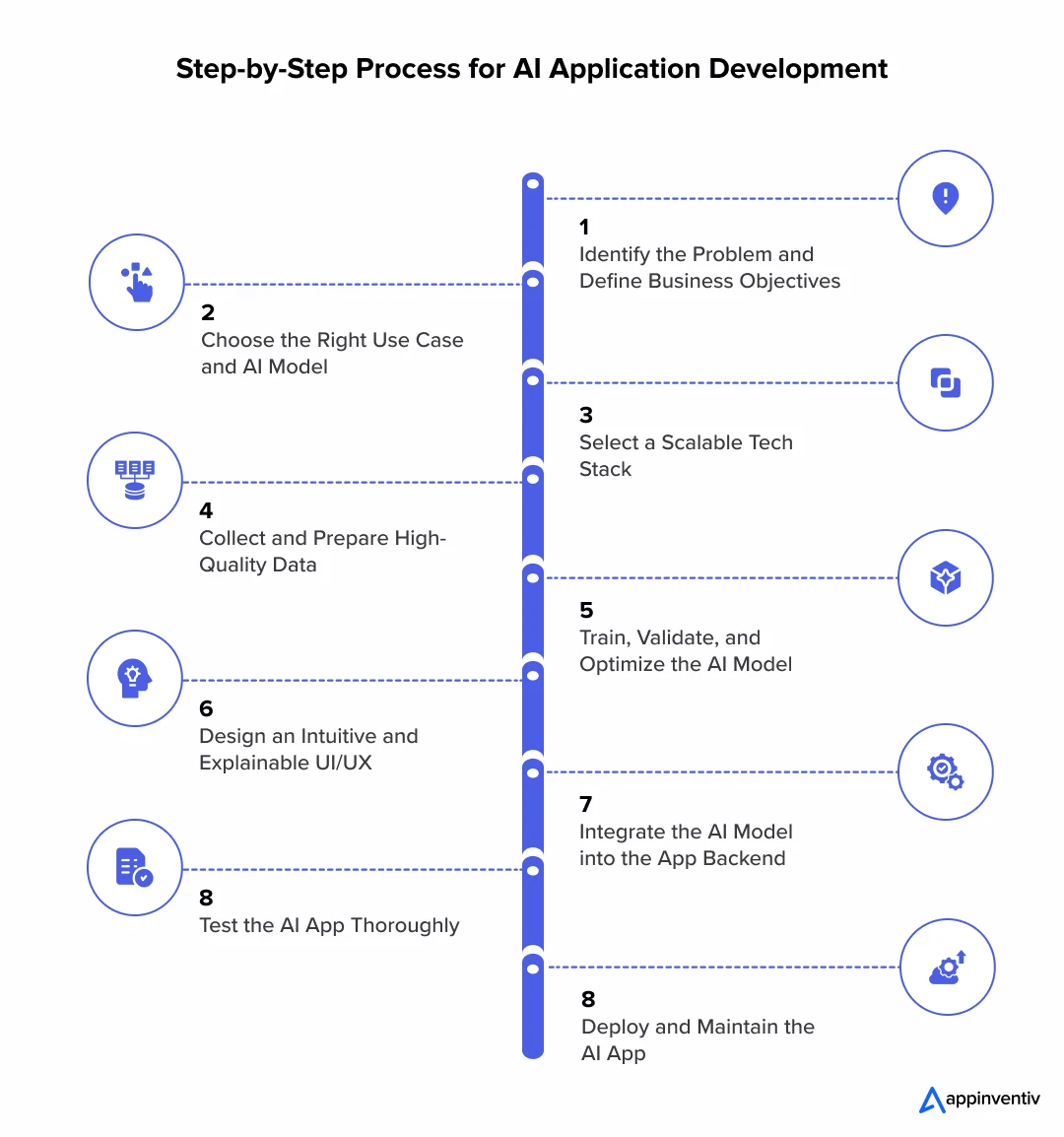
Identify the Problem and Define Business Objectives
The first and most critical step in any AI app development journey is to identify the problem you’re trying to solve and translate it into a well-defined business objective. Enterprises often fall into the trap of “AI for the sake of AI,” investing in solutions that don’t align with core KPIs. Instead, focus on how artificial intelligence can drive tangible impact—whether it’s automating repetitive tasks, increasing personalization, or enabling real-time analytics.
This step sets the tone for the entire AI application development process. For instance, a logistics company may aim to reduce route optimization time, while a financial institution may want to predict loan defaults using customer data. By identifying where inefficiencies exist or where human decision-making slows processes, you can anchor the development process around solving high-value problems. Clarity at this stage helps in prioritizing features, choosing the right AI model, and ultimately delivering ROI.
Practical tip: Before you begin to build an AI app, conduct internal discovery sessions to document pain points across departments. Use a prioritization matrix to align them with potential AI solutions, business value, and ease of implementation.
Choose the Right Use Case and AI Model
Once you know the problem, selecting the right use case and matching it with an appropriate AI model is vital. AI spans a wide range of capabilities—from natural language processing (NLP) to computer vision to reinforcement learning. Your choice should depend on the nature of the task, the type of data available, and how the app is expected to behave in real-time.
For example, if you’re developing an AI app that offers personalized financial advice, supervised learning with regression models or recommendation algorithms would be ideal. If you’re aiming for intelligent document processing, NLP models like BERT or RoBERTa can extract context-rich information. On the other hand, chatbots or voice assistants are best powered by transformer-based generative models like GPT.
Practical tip: Don’t reinvent the wheel—explore open-source pretrained models as a starting point. This reduces development time and lowers AI app development cost, especially in use cases where industry-standard models already perform well.
Select a Scalable Tech Stack
Your tech stack serves as the engine room of your AI application. From model training to deployment, every component—from frameworks to cloud infrastructure—must be selected with scalability, security, and future-proofing in mind. Python remains the go-to programming language for AI due to its robust ecosystem. Frameworks like TensorFlow, PyTorch, and Keras enable both research and production-level model training.
Practical tip: Choose a stack that supports modularity and hybrid deployments. This allows you to deploy part of your app at the edge (for speed) and the rest in the cloud (for power), a crucial capability when building AI-based mobile apps.
Recommended Tech Stack for AI App Development
| Layer | Technology Stack | Purpose |
|---|---|---|
| Programming Language | Python, JavaScript (Node.js), Java | Core development—Python for AI/ML, Node.js for backend, Java for Android |
| AI/ML Frameworks | TensorFlow, PyTorch, Keras | Building and training machine learning and deep learning models |
| Mobile Inference | TensorFlow Lite, Core ML, ONNX | Running AI models efficiently on mobile or edge devices |
| NLP Libraries | Hugging Face Transformers, spaCy, NLTK | Language modeling, chatbots, sentiment analysis |
| Computer Vision | OpenCV, YOLO, Detectron2 | Image/video analysis, object detection, facial recognition |
| Backend Development | FastAPI, Flask, Node.js | Building scalable APIs and application logic |
| Database | PostgreSQL, MongoDB, Firebase | Structured and unstructured data storage |
| Containerization | Docker, Podman | Packaging AI models and services for consistent deployment |
| Orchestration | Kubernetes, Docker Swarm | Managing containerized applications at scale |
| Cloud Platforms | AWS SageMaker, Azure ML, Google Vertex AI | Scalable model training, deployment, and monitoring |
| CI/CD & DevOps | Jenkins, GitHub Actions, GitLab CI/CD | Automating build, test, and deployment pipelines |
| Monitoring & MLOps | MLflow, Weights & Biases, Prometheus, Grafana | Tracking model performance and health in production |
| Version Control | Git, DVC (Data Version Control) | Code and data versioning for reproducibility and collaboration |
Collect and Prepare High-Quality Data
No AI model can outperform the quality of data it is trained on. Data preparation is not just about gathering massive volumes—it’s about ensuring relevance, balance, and cleanliness. This includes eliminating duplicates, labeling data accurately, handling missing values, and normalizing formats. AI application development requires both structured data (like spreadsheets, CRM logs) and unstructured data (like text, audio, or images), depending on your use case.
[Also Read: Preventing AI Model Collapse: Addressing the Inherent Risk of Synthetic Datasets]
If your goal is to make an AI app that learns from customer behavior, you’ll need to collect real-time user interactions, feedback loops, and contextual signals. For computer vision apps, annotated image datasets are essential. Healthcare and finance apps often need anonymized, regulation-compliant data, which adds another layer of complexity.
Practical tip: Use automated data labeling tools and invest in data versioning platforms like DVC or LakeFS. They streamline reproducibility and governance, which is crucial when building custom AI applications at scale.
Train, Validate, and Optimize the AI Model
Training the AI model is where your collected data meets computational intelligence. Here, your selected algorithm learns from the data patterns and builds predictive capabilities. But training is only the start. You must evaluate model performance using accuracy, precision, recall, and other metrics—and then iterate until it generalizes well.
For enterprises, it’s not enough to train a model that performs well in the lab; it must perform reliably in production. That’s why model validation (using a separate test set), bias mitigation, hyperparameter tuning, and cross-validation are essential steps. Enterprises also need to plan for continuous learning—training new versions of the model as fresh data becomes available.
Practical tip: Leverage tools like MLflow or Weights & Biases for experiment tracking, versioning, and monitoring. They help manage the lifecycle of AI models and reduce risks during AI mobile app development.
Design an Intuitive and Explainable UI/UX
A powerful AI app is useless if users don’t understand how to interact with it—or don’t trust it. That’s why user experience (UX) and explainability must go hand in hand. In AI-powered mobile application development, clarity and trust are key. Users should know when AI is being used, what it’s doing, and why certain recommendations or predictions are being made.
For instance, if you’re building an AI finance app that suggests investments, include small tooltips or overlays that explain the rationale behind suggestions. In healthcare apps, displaying confidence levels or uncertainty metrics can help doctors trust the AI’s recommendations.
Practical tip: Apply progressive disclosure in design—don’t overwhelm users upfront. Instead, provide AI explanations in layers based on user curiosity or need. Use UI frameworks that support dynamic interfaces like React Native or Flutter.
[Also Read: How Explainable AI can Unlock Accountable and Ethical Development of Artificial Intelligence]
Integrate the AI Model into the App Backend
This is where everything comes together. Your trained and validated AI model must now be integrated with the application’s backend logic so it can work in real-world scenarios. This step involves setting up APIs, containerizing the model (using Docker or TensorFlow Serving), and ensuring seamless communication between the model, database, and frontend.
When building AI-based mobile apps, it’s also crucial to optimize for low latency, especially if the model is being run on the edge or on-device. A recommendation system that takes 3 seconds to load will hurt user retention.
Practical tip: Use asynchronous processing wherever possible, especially for time-intensive inference tasks. Integrate fallback logic in case the AI fails or returns uncertain results—this builds resilience and enhances user trust.
Test the AI App Thoroughly
AI testing goes far beyond functional testing. It involves validating prediction accuracy, model bias, robustness under edge cases, performance under load, and overall system stability. Enterprises building AI apps must test both the app’s usability and the AI’s decision-making logic.
Security testing is especially critical in finance, healthcare, and eCommerce apps where sensitive data is involved. You’ll also want to conduct A/B testing to evaluate user response to AI-powered features versus traditional features.
Practical tip: Simulate real-world usage with synthetic data, edge cases, and incomplete inputs. Include user feedback loops in beta testing to gather subjective insights on AI outputs.
Deploy and Maintain the AI App
Once your app is fully tested, it’s ready to go live. But deployment isn’t the end—it’s the beginning of continuous improvement. AI models need to be retrained periodically, especially if they’re exposed to non-static data environments like customer behavior or market trends.
Deployment environments should include performance monitoring, logging, error tracking, and automated retraining pipelines. Also consider compliance updates—especially for apps in regulated industries.
Practical tip: Schedule post-launch check-ins (30/60/90 days) to evaluate how well the model is performing in production. Set up dashboards with KPIs like accuracy drift, user engagement, or feature adoption to track AI performance in real-time.
To keep your AI app accurate, secure, and adaptable over time, implement the following key strategies:
| Strategy | Purpose |
|---|---|
| Monitor Model Drift | Detect changes in data patterns that affect model accuracy |
| Schedule Retraining Cycles | Regularly update models to maintain relevance and performance |
| Collect User Feedback | Identify usability issues and refine AI behavior based on real-world input |
| Update Security Protocols | Address new vulnerabilities and ensure ongoing data protection |
| Add Versioning for Model & Data | Track changes, enable rollback, and support reproducibility |
Game-Changing Features of an AI App
Building AI applications requires incorporating features that can significantly enhance user experience, drive engagement, and streamline operations. While the specific features of an AI app can vary based on the industry and project requirements, certain capabilities are universally valuable. Here are some common AI app development features that will make your apps stand out in today’s competitive market.
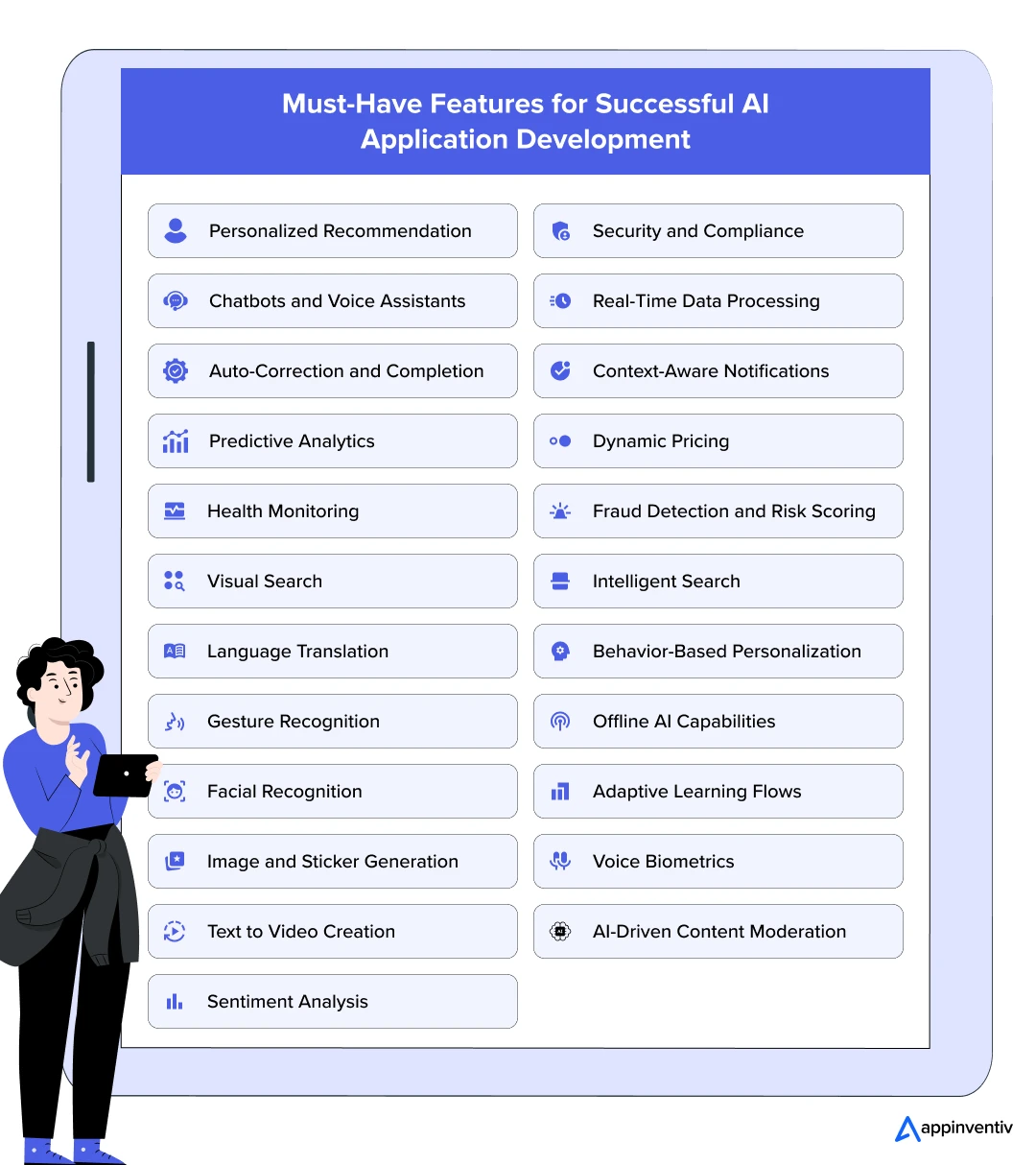
Personalized Recommendation
An AI-powered personalized recommendation system analyzes user behavior, preferences, and past interactions to suggest tailored content, products, or services. This feature enhances user engagement, leading to increased user retention and higher conversion rates.
Chatbots and Voice Assistants
AI-powered chatbots and voice assistants provide instant, 24/7 customer support. They can efficiently handle a wide range of queries, freeing up human resources for more complex, value-added tasks.

Auto-Correction and Completion
The auto-correction and text completion feature assists users by automatically correcting spelling errors and predicting the next word or phrase. These functionalities improve typing speed, efficiency, and accuracy, making communication faster and reducing errors. This feature is especially beneficial in social media messaging apps and word processors.
Predictive Analytics
Predictive analytics in AI apps analyzes historical data and predicts future outcomes, helping businesses anticipate trends, optimize strategies, and improve performance. This feature is invaluable for data-driven decision-making in various industries, including finance, healthcare, retail, and marketing.
Health Monitoring
To build an AI app that offers it all, integrating features like health monitoring helps businesses to track and analyze health-related data, such as heart rate, physical activity, and sleep patterns. This paves the way for better insights and alerts, helping users identify health issues early before they become severe and maintain their well-being, thereby improving patient care.
Visual Search
AI powered visual search enables users to search for their desired product using images rather than text. This feature utilizes computer vision technology to detect pictures, allowing users to find products, information, or similar images quickly and accurately. It is particularly useful in the retail and eCommerce sectors, enhancing user engagement and the shopping experience.
Language Translation
Language translation translates text or speech from one language to another in real-time. This feature breaks down language barriers, facilitating smooth communication and interaction in a globalized world. This functionality is essential for international business, travel, and hospitality sectors, facilitating multilingual customer support. To make an AI app that stands out, companies must consider integrating real-time, multi-language translation features that can significantly boost global communication and market reach.
Gesture Recognition
The gesture recognition feature interprets human gestures, allowing users to interact with devices through movements. This feature enhances user experience by providing a more natural and intuitive way of interacting with technology. It is used in gaming, virtual reality, and smart home applications.

Facial Recognition
Facial recognition helps identify and verify individuals based on their facial features. This technique is widely used for security purposes, such as unlocking devices, authentication in apps, and surveillance. Industries such as finance, healthcare, and law enforcement can particularly leverage this feature during AI application development to prevent data theft and fraudulent transactions.
Image and Sticker Generation
AI generates custom images and stickers based on user input or predefined templates. This feature enhances creativity and personalization in applications related to social media, design, and digital content creation.
[Also Read: How Much Does It Cost to Build an AI Art Generator App Like Imagine]
Text to Video Creation
AI converts written content into engaging video formats, incorporating visuals, animations, and voiceovers. This capability streamlines the content creation process, making it easier to produce professional-quality videos from text scripts easier with minimal effort.
Related Article: What is the Cost to Develop an AI Platform like Sora
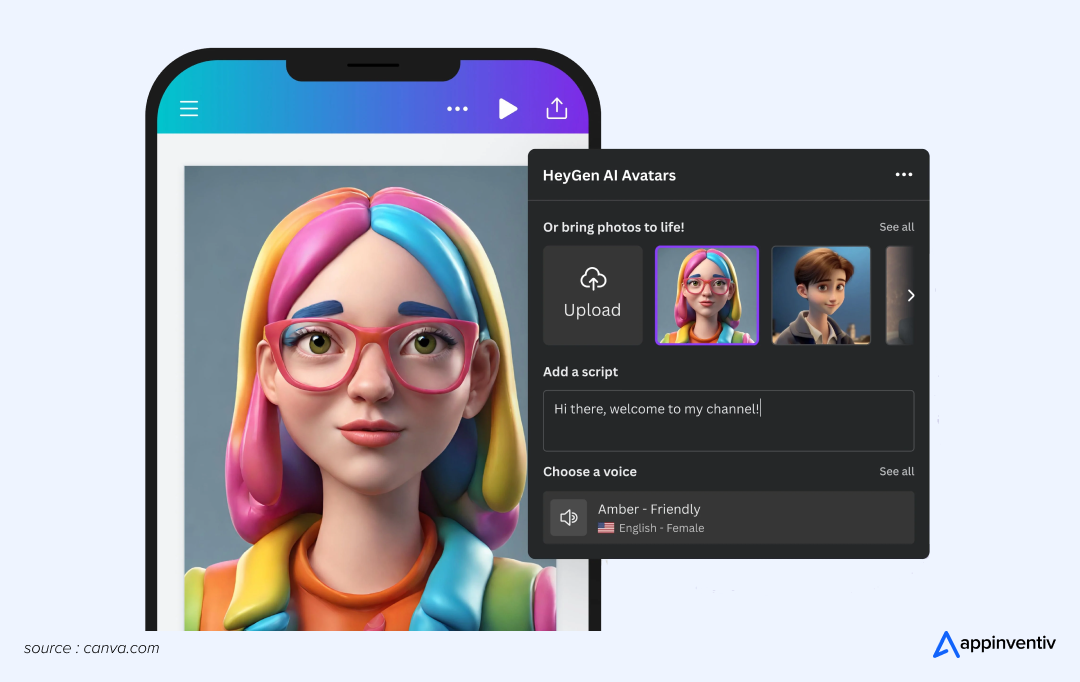
Sentiment Analysis
Sentiment analysis is a core feature to make an AI app that determines the emotional tone behind a piece of text. This feature is valuable for understanding customer feedback, monitoring social media, and improving customer service. By analyzing sentiments, businesses can gain insights into customer emotions and tailor their marketing strategies accordingly.
Security and Compliance
Ensuring security and privacy is paramount for any application, and AI apps are no exception. Robust security measures, such as data encryption and user authentication, protect sensitive information from unauthorized access and cyber threats. Additionally, compliance with industry regulations, such as GDPR and HIPAA, helps ensure that AI apps meet legal and ethical standards while protecting user privacy.
Real-Time Data Processing
Real-time data processing allows AI apps to analyze and act on data as it is generated. This feature is critical for applications that require immediate responses, such as financial trading, fraud detection, and live customer support. It enhances the app’s responsiveness and provides up-to-date insights, improving user experience and operational efficiency.
Context-Aware Notifications
AI-powered mobile application development often includes smart notification systems that adapt to user behavior, location, and context. These context-aware alerts ensure that users receive timely and relevant prompts rather than generic messages. For instance, a fitness app can notify users to hydrate after intense activity, or a banking app might suggest saving insights based on recent spending patterns. These features of an AI app significantly enhance engagement and personalization.
Dynamic Pricing
Dynamic pricing uses AI to adjust prices in real time based on demand, competition, customer behavior, and other market factors. Common in travel, hospitality, and eCommerce, this feature helps businesses maximize revenue and remain competitive. When you make an AI app for such use cases, integrating dynamic pricing not only improves profitability but also delivers more targeted, data-driven offers to users.
Fraud Detection and Risk Scoring
For sectors like fintech, insurance, and eCommerce, ML fraud detection is a core feature in AI application development. ML algorithms can analyze patterns in real time, identify anomalies, and trigger alerts for suspicious transactions or user behavior. Incorporating this feature while building AI applications helps reduce financial risk and boosts consumer trust through proactive security.
Intelligent Search
AI-enhanced search functions go beyond keyword matching to understand user intent, synonyms, context, and even past interactions. This feature is critical when you build an app with AI that relies heavily on product discovery, knowledge bases, or support documentation. It can significantly reduce bounce rates and improve conversions by returning smarter, faster, and more accurate results.
Behavior-Based Personalization
Instead of using static user profiles, behavior-based personalization tracks real-time user activity—such as scrolls, clicks, time spent on pages, and navigation flows—to adapt the app experience dynamically. This is one of the most powerful benefits of AI application development, especially in retail, media, and learning platforms where user preferences evolve constantly.
Offline AI Capabilities
As AI mobile app development matures, the ability to process AI logic offline—on the device itself—is becoming increasingly critical. Apps that use TensorFlow Lite or Core ML can run models locally, ensuring responsiveness and privacy even without internet connectivity. This is especially valuable in building AI-based mobile apps for healthcare, field operations, or travel where connectivity can’t always be guaranteed.
Adaptive Learning Flows
In educational apps, adaptive learning is a standout use case of an AI app. By analyzing learner progress, strengths, and weaknesses, the app can adjust lesson sequences, difficulty levels, and content formats. This creates a truly personalized experience that improves learning outcomes, making it a must-have for edtech-focused AI app development.
Voice Biometrics
Voice biometrics enables authentication through voice recognition by analyzing unique vocal patterns. This feature improves security and reduces friction in login experiences, particularly in AI-powered financial and customer support apps. When you develop an AI app with voice interfaces, adding biometric validation can enhance both safety and accessibility.
AI-Driven Content Moderation
For social platforms, forums, or any user-generated content ecosystem, AI-powered content moderation is essential. These features use NLP and computer vision to detect inappropriate language, hate speech, violence, and more—often in real time. Integrating moderation during AI application development ensures compliance and creates a safer user environment without over-reliance on manual oversight.
By focusing on these must-have features, you can understand the answer to the question- how to create an AI app- that meets the highest standards of innovation, security, and usability in today’s AI-driven age.
Let’s build intelligent apps with smart automation, real-time insights, and personalized UX.
How Much Does It Cost to Build an AI App?
There is no one-size-fits-all formula to quote the exact cost to make an AI app; it varies widely depending on various factors. The factors affecting AI app development cost include but are not limited to the project’s complexity, features, quality and quantity of data, chosen tech-stack, platform compatibility, location of the AI development company, and so on.
On average, building an AI app can range from $30,000 to $300,000 or more. However, this is a rough estimate; the final cost can increase or decrease depending on your unique project requirements.
Also Read: Hiring Offshore AI Engineers in New York – A Step-by-Step Process and Costs
Here is a table outlining the estimated timeline and cost of building an AI app, depending on the project’s complexity and features.
| App Complexity | Average Timeline for AI App Development | Average Cost of AI App Creation | Examples |
|---|---|---|---|
| Simple AI app with basic features | 4-6 months | $30,000-$50,000 | Chatbot and virtual assistant for customer service |
| Medium AI app with moderate features | 4-9 months | $50,000-$120,000 | Financial literacy app like Edfundo |
| Highly complex AI app with advanced features | 9 months to 1 year or more | $120,000-$300,000 or more | Healthcare diagnostic apps with real-time communication, like YouComm |
Factors Affecting the Cost to Build an AI App
The cost to build an AI app can vary widely depending on several key factors. Understanding these elements can help businesses better plan and budget for their AI projects, ensuring they align with financial constraints and strategic goals. Here are some of the major factors affecting AI app development cost:
Complexity of Features
The more complex the AI features, the higher the development cost. Advanced functionalities like natural language processing, machine learning algorithms, or computer vision require more time and expertise to develop, thus increasing the project’s expense.
Data Management Needs
AI applications depend heavily on data. The cost of AI app creation will escalate if the app requires extensive data collection, cleaning, integration, and management. Secure handling and storage of data also add to the development expenses.
Integration with Existing Systems
Integrating AI with current business systems and software can be complex and add to the overall AI app development cost. The more legacy systems an AI app needs to interact with, the more expensive and time-consuming the integration will be.
Choice of Technology and Tools
The technologies and tools selected to build the AI app can significantly impact costs. Proprietary solutions might offer robust features but at a higher price, while open-source tools can reduce expenses but may require additional customization.
Development Team Expertise
The skill level and experience of the development team are crucial. Hiring top-tier AI developers or specialists can drive up costs to create an AI app, but their expertise can result in a more successful and efficient app.
Regulatory Compliance
AI apps must comply with strict regulations for certain industries like finance or healthcare. Ensuring compliance can involve additional layers of security and validation, thereby increasing the overall cost of AI application development.
Ongoing Maintenance and Updates
AI apps require continuous updates and maintenance to stay effective and secure. The cost of regular updates, training, and developing AI models with new data, and maintaining system performance over time should be factored into the total cost.
Testing and Quality Assurance
Rigorous testing is essential to ensure the AI app functions correctly and meets all requirements. Comprehensive testing can add to the overall cost of building an app with AI but is critical to prevent failures after deployment.
Discuss your project idea with our AI team now
Understanding Monetization Models for AI Applications
AI apps don’t just drive operational efficiency—they open new streams of revenue. Choosing the right monetization strategy is crucial to ensuring long-term sustainability, user adoption, and ROI. Here’s a breakdown of the most common and effective monetization models for AI-powered applications:
| Model | Description | Ideal Use Cases |
|---|---|---|
| Subscription-Based | Users pay a recurring fee (monthly/yearly) to access the AI app or platform. | SaaS tools, AI analytics platforms, productivity & business AI software |
| Freemium + Pay-Per-Use APIs | Basic access is free; users pay for advanced features or API usage. | AI APIs (e.g., vision, NLP, voice), developer tools, chatbot platforms |
| Ad-Based | Revenue is generated through in-app advertisements shown to users. | Consumer-facing AI apps like voice assistants, media apps, social AI |
| Licensing & White Labeling | The AI model or app is licensed to other companies under their branding. | Enterprise-grade AI solutions, B2B platforms, OEM partnerships |
| Data Monetization | Anonymized data insights are sold to third parties for research or analytics. | Fintech, healthcare, retail AI apps with large user behavior datasets |
Future Trends in AI Application Development
AI app development is rapidly evolving due to changing user expectations and technological advancements. Here are some key trends in AI app development businesses can look forward to in the future:
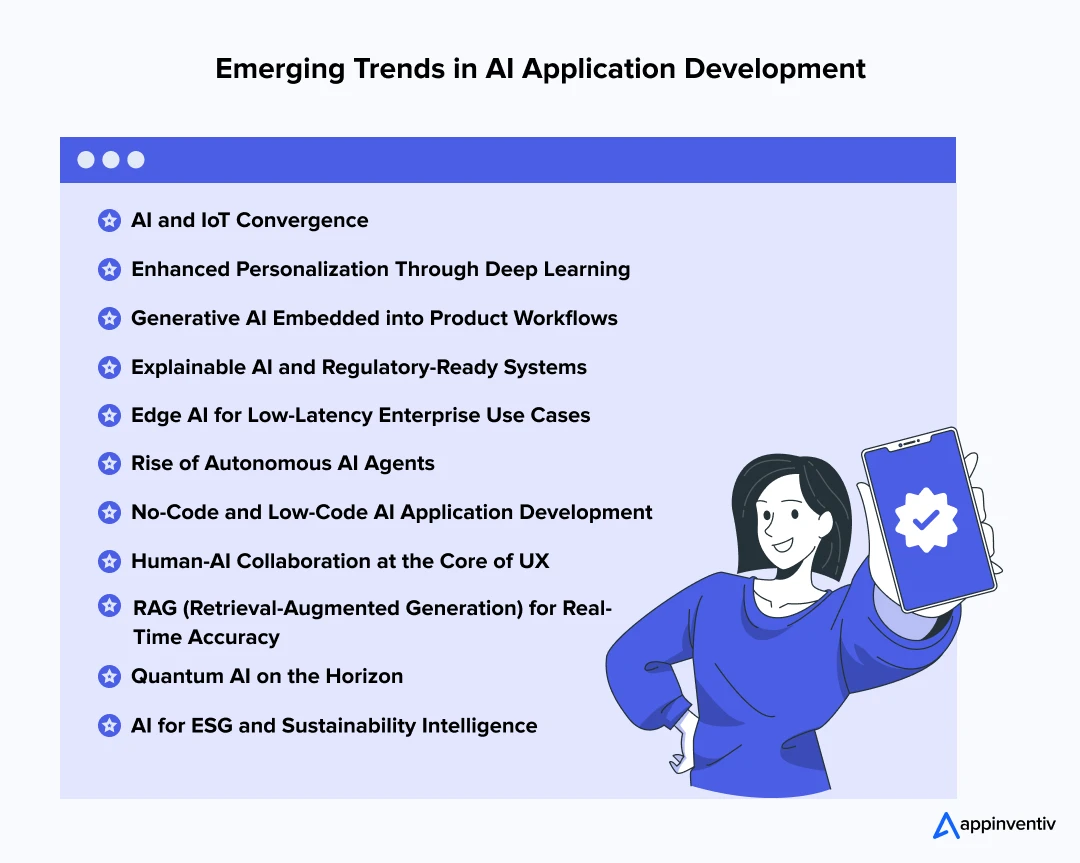
AI and IoT Convergence
The convergence of AI and IoT is transforming traditional operations into real-time, intelligent ecosystems. By embedding AI in IoT networks—whether in smart factories, predictive maintenance systems, or energy grids—enterprises can develop AI apps that analyze vast device data to detect anomalies, predict failures, and optimize performance on the fly. This AI-powered mobile application development approach empowers industries like manufacturing and logistics to shift from reactive to predictive operations, minimizing downtime and driving efficiency at scale.
Enhanced Personalization Through Deep Learning
Personalization is moving far beyond name-based greetings or basic segmentation. Enterprises are leveraging AI app development to build hyper-personalized experiences using behavioral clustering, real-time feedback loops, and adaptive learning models. Whether it’s tailoring learning content in edtech or customizing financial portfolios in wealth management apps, building AI applications with deep personalization capabilities ensures higher retention, engagement, and revenue uplift across enterprise platforms.
Generative AI Embedded into Product Workflows
Generative AI Development is no longer just for marketing copy or image creation. Businesses are now embedding it within their core platforms—auto-generating product descriptions in eCommerce, drafting legal clauses in contract software, or summarizing patient notes in healthcare. For enterprises looking to make an AI app, the ability to plug generative models into domain-specific workflows is unlocking new efficiencies and content agility across sectors.
Explainable AI and Regulatory-Ready Systems
As AI systems become critical in high-stakes domains—such as finance, healthcare, and legal tech—enterprises are prioritizing transparency. AI application development now increasingly includes explainability modules that justify decisions, score confidence levels, and flag bias. These features are vital not just for compliance with GDPR, HIPAA, and AI Act standards but also to gain stakeholder trust and institutional adoption of AI-powered tools.
Edge AI for Low-Latency Enterprise Use Cases
In scenarios where every millisecond matters—autonomous vehicles, industrial robotics, on-device fraud detection—AI models can’t afford cloud dependency. Enterprises are increasingly building AI-based mobile apps using edge AI, deploying models directly on devices to enable offline processing, faster inference, and greater data privacy. This decentralization of intelligence is revolutionizing how enterprises serve customers in real-time, especially in mobility, logistics, and healthcare.
Rise of Autonomous AI Agents
Business Autonomous agents are evolving beyond chatbots to full-blown digital workers. These agents can plan, act, learn, and optimize continuously—whether they’re automating supply chain decisions, managing inventory, or orchestrating multi-step workflows. For enterprises wondering how to build an AI app that reduces human workload, autonomous agents represent a leap toward intelligent process automation, boosting operational efficiency and reducing overheads.
No-Code and Low-Code AI Application Development
To democratize access to AI, many enterprises are embracing no-code and low-code AI app development platforms. These tools allow business users and analysts to build, test, and deploy intelligent apps without writing extensive code. This approach not only accelerates AI mobile app development timelines but also reduces dependency on scarce AI talent—crucial for teams under pressure to deliver rapid innovation.
Human-AI Collaboration at the Core of UX
The future of AI app development is not about replacing humans—but empowering them. Whether in law firms using AI to summarize case laws or marketers using AI co-pilots for campaign optimization, the best apps are built for human-AI symbiosis. Building custom AI applications that include editable suggestions, explainable insights, or override options ensures users remain in control while still benefiting from intelligent assistance.
RAG (Retrieval-Augmented Generation) for Real-Time Accuracy
Retrieval-Augmented Generation (RAG) combines the power of search and generation, pulling information from proprietary enterprise datasets before responding. This is especially useful in customer service, internal knowledge management, and legal apps where hallucinations from pure LLMs could be costly. Enterprises looking to develop an AI app with reliable and grounded responses should consider integrating RAG for enhanced trust and accuracy.
Quantum AI on the Horizon
Quantum computing holds the potential to exponentially accelerate AI algorithms—especially in optimization, drug discovery, and logistics. While it’s still nascent, enterprises investing in future-proof AI infrastructure are exploring how to create an AI app that can eventually harness quantum speed-ups. Early experimentation today can lead to significant competitive advantages when quantum-powered machine learning becomes mainstream.
AI for ESG and Sustainability Intelligence
With regulatory and stakeholder pressure mounting around sustainability, enterprises are turning to AI app development to track carbon footprints, model ESG impact, and automate sustainability reporting. From real-time energy optimization to supply chain transparency, AI-powered mobile application development is evolving to help organizations meet environmental goals while staying compliant and competitive.
Overcoming Challenges in AI App Development: Strategic Insights for Enterprises
The consideration to build an AI app is a rewarding endeavor. Still, it comes with challenges that need to be overcome efficiently to realize the full potential of AI applications. Here are some of the most common hurdles you need to overcome when considering how to develop an AI application.
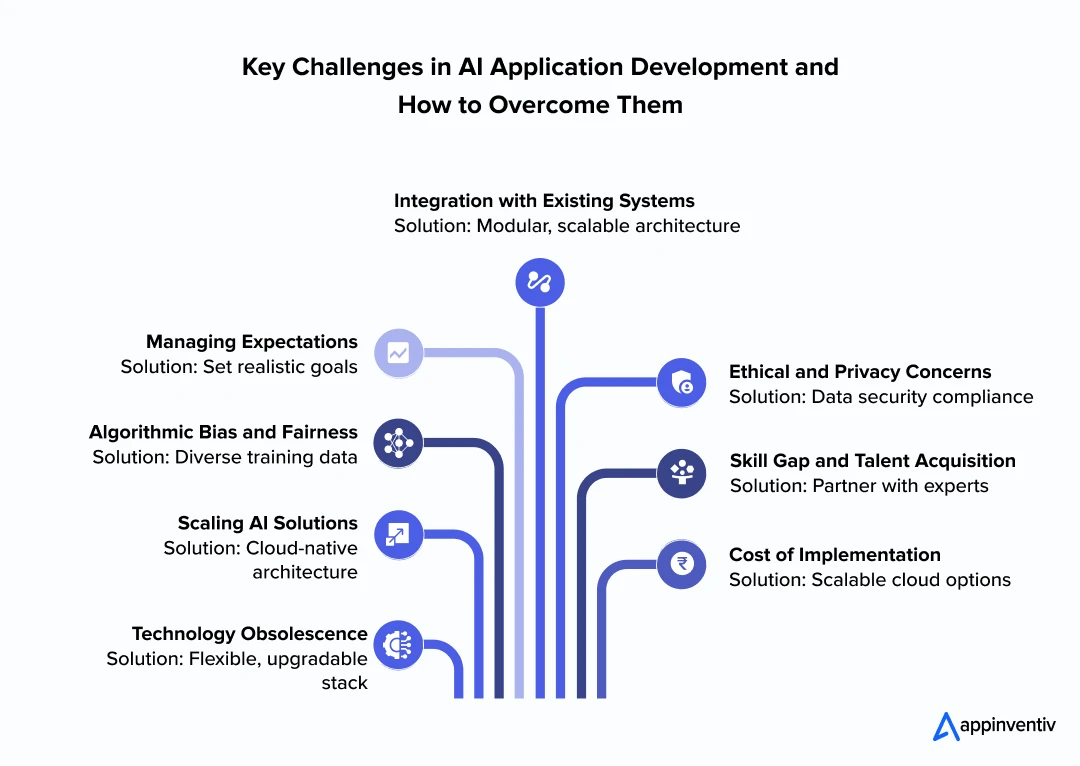
Integration with Existing Systems
Challenge: Integrating AI applications with existing infrastructure can be complex and may cause compatibility issues.
Solution: Design your AI components with modularity, scalability, and flexibility in mind. Regularly test and validate the integrated system to address compatibility issues early.
Ethical and Privacy Concerns
Challenge: AI applications are made to handle sensitive user information and business data, which may raise data breaches, privacy, and ethical concerns.
Solution: Implement robust data security measures and comply with relevant regulations, such as GDPR and CCPA, to protect user privacy and sensitive data.
Also Read: Explainable AI benefits every AI enthusiast should know
Skill Gap and Talent Acquisition
Challenge: AI app creation requires a specific set of highly specialized skills and currently in short supply. Finding and retaining the right talent can be challenging and expensive.
Solution: Partnering with a dedicated AI agent app development firm with expertise in AI apps can help bridge this skill gap. Such firms bring seasoned professionals who can deliver high-quality AI solutions efficiently, allowing your business to leverage advanced AI capabilities without the overhead of recruiting and training specialized staff.
Cost of Implementation
Challenge: The initial cost of AI application development and deployment can be prohibitively high, especially for startups and small businesses.
Solution: Consider cloud-based AI services that offer scalable pricing models. Applying for grants and innovation credits can also help manage costs.
Managing Expectations
Challenge: There is often a mismatch between stakeholder expectations and the practical outcomes AI can deliver, especially in the early stages of implementation.
Solution: Set realistic goals for AI projects and keep stakeholders informed throughout the development process. Pilot projects can help demonstrate tangible benefits and refine objectives before full-scale deployment.
Algorithmic Bias and Fairness
Challenge: AI systems can easily become biased based on the data they are trained on, leading to unfair outcomes for certain user groups.
Solution: Use diverse datasets to train AI models and minimize bias. Implementing AI ethics guidelines and regularly auditing AI systems for bias can also ensure fairness in AI operations.
Scaling AI Solutions
Challenge: As businesses grow, scaling AI applications to meet increased demands without losing performance can be difficult.
Solution: Design AI systems with scalability in mind from the very beginning. Utilize cloud infrastructures that dynamically adjust resources based on the app’s needs.
Technology Obsolescence
Challenge: The rapid pace of technological advancement in AI can quickly render systems obsolete, posing a challenge for long-term investment in AI technologies.
Solution: Use a flexible development approach that allows easy updates and integration of new AI technologies. Stay ahead of AI trends and developments to anticipate and prepare for technological shifts.
Data Collection, Privacy, and Model Training Challenges in AI App Development
When enterprises begin to build an AI app, the biggest roadblock isn’t the code or the algorithm—it’s the data. Data is the foundation of any intelligent system, and its quality, diversity, and ethical handling directly determine the success of AI-powered mobile application development. However, most organizations quickly realize that managing data isn’t just a technical hurdle—it’s a strategic challenge that affects compliance, user trust, model performance, and ultimately, business outcomes.
The Data Dilemma in Enterprise AI Projects
To develop an AI app that delivers real-time, contextual intelligence, enterprises need vast amounts of structured and unstructured data. But real-world data is often incomplete, siloed across departments, poorly annotated, or heavily biased—leading to subpar model outputs. In sensitive industries like healthcare or finance, flawed training data can cause compliance violations or reinforce harmful stereotypes.
Moreover, when building AI applications, enterprises must ensure that their data pipelines are aligned with global privacy standards such as GDPR, HIPAA, and CCPA. Mishandling personally identifiable information (PII) can lead to lawsuits, brand damage, and regulatory scrutiny—making robust data governance non-negotiable.
The Cold Start Problem in Custom AI Application Development
For companies looking to build custom AI applications, another major challenge is the cold start problem—where you don’t yet have enough historical data to effectively train machine learning models. This slows down AI mobile app development and forces teams to rely on either synthetic data, external datasets, or transfer learning. But these alternatives have their own limitations, especially when building highly specialized enterprise-grade solutions.
Model Training Complexities and Infrastructure Costs
Training large AI models from scratch requires not only clean and labeled data but also high-performance computing infrastructure. The cost of model retraining, experimentation, and fine-tuning adds significant weight to the AI app development cost, especially for startups or mid-size enterprises. Additionally, training pipelines must be robust enough to detect and respond to data drift, ensuring that the AI app remains relevant and accurate over time.
Strategic Approaches for Enterprises
To overcome these hurdles, enterprises should focus on building strong data pipelines during the AI application development phase. Some practical strategies include:
- Using federated learning to train models across decentralized data sources without compromising privacy
- Leveraging synthetic data to simulate training environments when real data is limited
- Implementing data versioning and audit trails to maintain regulatory compliance
- Incorporating privacy-preserving AI techniques like differential privacy and homomorphic encryption
By adopting a data-first mindset, enterprises can significantly reduce risks and improve ROI when they make an AI app. Smart data governance not only ensures regulatory compliance but also increases the adaptability and accuracy of AI models in production.
Now that we know how to use AI to build an app and ensure its future growth, let’s uncover the various applications of AI, transforming businesses across industries.
How to Measure the ROI of Your AI App
Building an AI app is a strategic investment—but how do you know it’s actually delivering value? Measuring the return on investment (ROI) of AI application development requires a mix of performance, efficiency, and business impact metrics that go beyond vanity numbers.
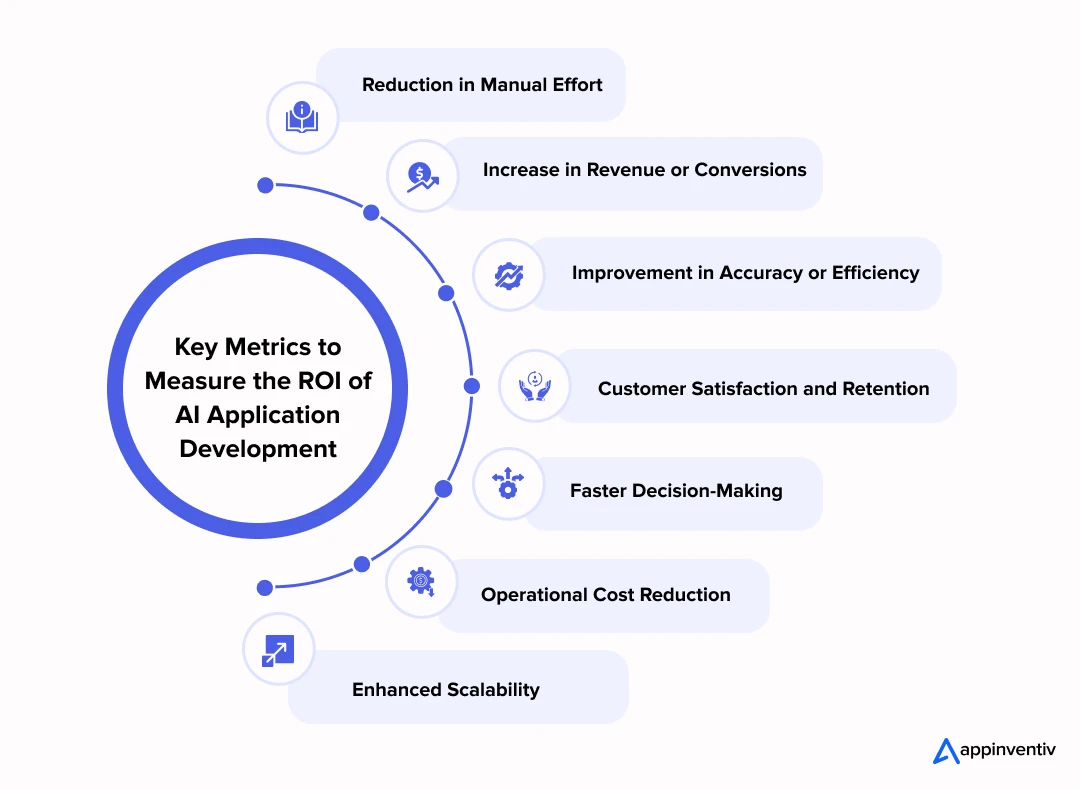
Reduction in Manual Effort
One of the most direct ways to measure ROI is by calculating how much manual work the AI app automates. Whether it’s processing invoices, reviewing contracts, or tagging images, fewer human hours translate to tangible cost savings. This is especially valuable in AI-powered mobile application development for operations-heavy industries.
Increase in Revenue or Conversions
If your AI app powers recommendation engines, personalized marketing, or predictive sales strategies, you can track uplifts in conversions or average order value. AI application development focused on eCommerce, fintech, or SaaS often yields measurable revenue growth through targeted automation.
Improvement in Accuracy or Efficiency
AI apps are designed to reduce errors—whether in diagnosing patients, forecasting demand, or recognizing objects. Measuring the improvement in accuracy or time-to-task completion is a strong indicator of AI ROI, especially for computer vision and NLP-based apps.
Customer Satisfaction and Retention
Apps that use AI for personalization, smart support, or proactive insights typically see higher customer satisfaction. Metrics like CSAT, NPS, and retention rates can validate the effectiveness of AI application development in improving user experience and brand loyalty.
Faster Decision-Making
One key benefit of AI-powered mobile application development is enabling faster, data-driven decisions. Whether it’s in logistics routing, financial planning, or content moderation, reduced decision-making time directly correlates with increased agility and better outcomes.
Operational Cost Reduction
By automating repetitive processes and optimizing workflows, AI apps reduce overhead. This includes savings on salaries, infrastructure, error remediation, and downtime. For enterprise-grade AI apps, these reductions can significantly impact bottom-line performance.
Enhanced Scalability
AI application development allows you to serve more users, process more data, or handle more queries without proportional cost increases. ROI can be measured by the increase in system throughput or customer reach without increasing your team size.
How Can Appinventiv Help You Build an AI App That Makes an Impact?
We hope this AI app development guide has helped you understand the intricacies involved in building an intelligent app that can transform your business. When evaluating how to build an app with AI or how to integrate AI into an app, partnering with a seasoned AI app development company like Appinventiv can make all the difference. We possess an in-depth understanding of emerging technologies and an unwavering commitment to innovation. From initial planning to deployment and beyond, our team of 1600+ tech evangelists brings a wealth of knowledge and expertise to the table, ensuring your AI app not only meets but exceeds industry standards.
We combine technical prowess with strategic insight, ensuring that every aspect of your AI app is tailored to align with your specific business goals. Whether you are aiming to enhance customer engagement, streamline operations, or unlock new business opportunities, our custom AI services will stand by you through every step of the digital transformation journey in this AI-driven era.
Here are the examples of our some successful AI-driven projects:
- Tootle: We developed an interactive intelligent agent – Tootle, that enhances user interactions through advanced AI, improving user engagement and operational efficiency.
- JobGet: Our experts leveraged AI to build JobGet that streamline the job search process and match candidates with suitable job opportunities.
- Chat & More: This advanced AI chatbot solution provides personalized customer service and engagement.
- HouseEazy: We have also developed an AI-driven real estate app – HouseEazy, that automates property price predictions based on parameters like location, number of bedrooms, and other features.
What are you still waiting for? Partner with us now and witness transforming your AI vision into a groundbreaking reality. With Appinventiv, you don’t just build an AI app; you build a state-of-the-art solution that stands out in this digitally growing era.
FAQs
Q. What are the benefits of AI application development?
A. There are numerous benefits of AI application development, such as:
- Enhanced Automation: One of the most known benefits of AI application development is the automation of repetitive tasks and processes, reducing manual errors.
- Personalized User Experiences: AI enables tailored interactions and recommendations, adapting the products and services to individual user preferences and behaviors.
- Increased Efficiency: AI-driven applications optimize operational workflows and processes across departments, resulting in faster and more accurate outcomes.
- Improved Decision-Making: By providing data-driven insights and predictions, AI apps support more informed decision-making for businesses.
- Predictive Insights: AI analyzes market trends and patterns to predict future events, offering valuable foresight for demand forecasting and planning.
Q. How to manage privacy, security and compliance challenges in AI development?
A. Managing privacy, security, and compliance during the AI app development process involves several key practices, such as:
For Privacy Challenge
- Use data anonymization to protect personal information.
- Implement differential privacy to analyze data without compromising individual privacy.
- Apply secure multi-party computation for collaborative environments.
For Security Challenge
- Employ robust authentication and access controls.
- Conduct regular security audits to identify and address vulnerabilities.
- Incorporate adversarial training to enhance model resilience against attacks.
For Compliance Challenge
- Perform regular compliance reviews to stay updated with regulations.
- Develop and adhere to ethical AI frameworks.
- Ensure transparency and explainability in AI systems to meet regulatory requirements.
Q. What is the cost and timeline to build an AI application?
A. The cost and timeline to make an AI application varies depending on various factors including the project’s complexity, platform compatibility, chosen tech stack, data requirements, expertise of AI app development company and so on.
On average, a simple AI app with basic features typically costs between $30,000 and $50,000 and takes 4-6 months to develop, while a medium-complexity app costs around $50,000 and $120,000 and takes 4-9 months to complete. Highly complex AI applications with advanced functionalities may cost between $120,000 and $300,000 or more and require around 9 months to over a year, depending on your unique project requirements.
Get in touch with us to get a more precise estimate for the AI application development timeline.
Q. How AI app development is reshaping the tech industry?
A. AI app development is fundamentally reshaping the tech industry by enabling smarter, more adaptive, and highly personalized digital experiences. From automating complex workflows and enhancing customer service with intelligent chatbots to powering predictive analytics and real-time decision-making, AI is driving innovation across sectors.
Companies are now embedding AI into the core of their products—whether it’s through voice recognition, recommendation engines, or computer vision—transforming traditional software into intelligent systems. As a result, businesses are seeing faster product cycles, improved efficiency, and new revenue models, making AI application development a critical differentiator in today’s competitive tech landscape.
Q. How to integrate AI into an app?
A. Integrating AI into an app involves embedding machine learning models or intelligent algorithms into the application’s workflow to enhance its capabilities. Here are the steps businesses need to follow:
- Define the problem: Identify what AI should solve—recommendations, image recognition, chat support, etc.
- Choose the right AI model: Use pre-trained models (like BERT, GPT, YOLO) or build a custom one.
- Prepare your data: Gather and clean data relevant to your use case for accurate training.
- Select a tech stack: Use tools like TensorFlow, PyTorch, CoreML, or ONNX for integration.
- Connect the AI with backend logic: Use APIs or SDKs to embed the AI model into your app architecture.
- Test and optimize: Evaluate performance using metrics and refine as needed for better results.
Q. How to build an app with AI?
A. Building an app with AI means developing an application from the ground up with artificial intelligence at its core. Here are the steps you need to take:
- Start with a use case: Define what intelligence the app will deliver (e.g., predictions, automation, personalization).
- Gather quality data: AI apps depend on clean, relevant, and high-volume datasets.
- Develop and train models: Use AI/ML frameworks like TensorFlow or PyTorch to create models.
- Build the frontend and backend: Use standard app development tools (React Native, Node.js, etc.) alongside AI modules.
- Integrate and deploy: Connect the trained models to the app and deploy on cloud or edge platforms.
- Monitor and update: Continuously track AI performance and retrain models with new data over time.


- In just 2 mins you will get a response
- Your idea is 100% protected by our Non Disclosure Agreement.
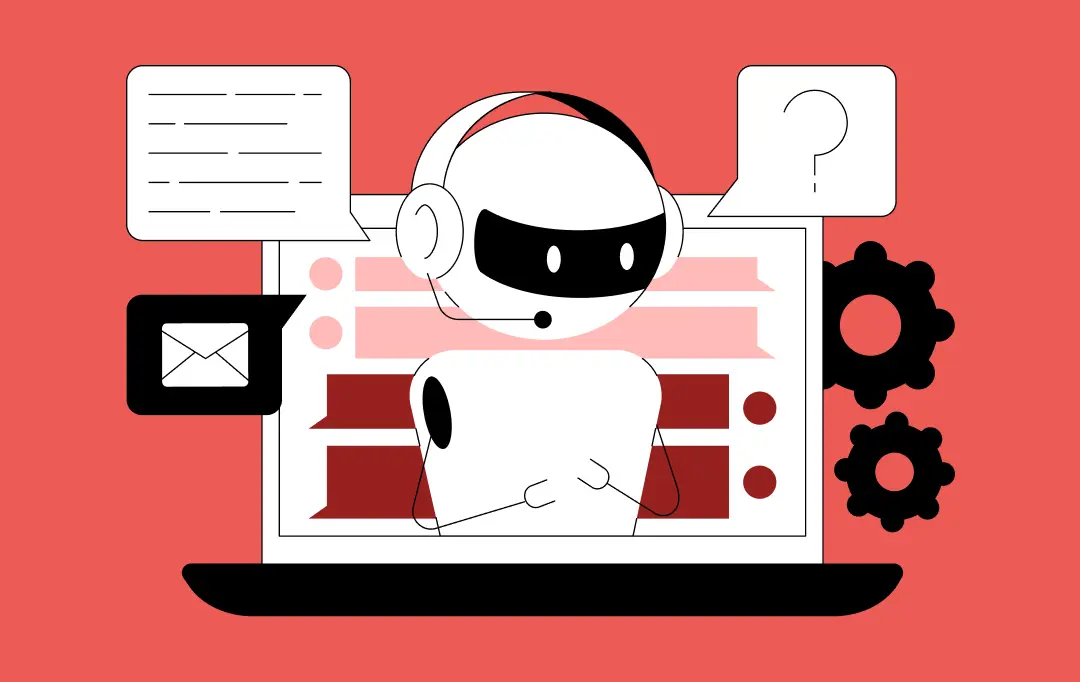
How to Build a Custom Multilingual Chatbot? Features, Process, Costs
Key takeaways: Multilingual Chatbots Drive Revenue Growth: Companies see higher conversion rates when customers can interact in their native language, with nearly 75% of global customers preferring to buy from websites in their preferred language. Beyond Translation to Cultural Intelligence: Successful implementations require cultural adaptation, not just language translation. Systems must understand context, emotion, and…
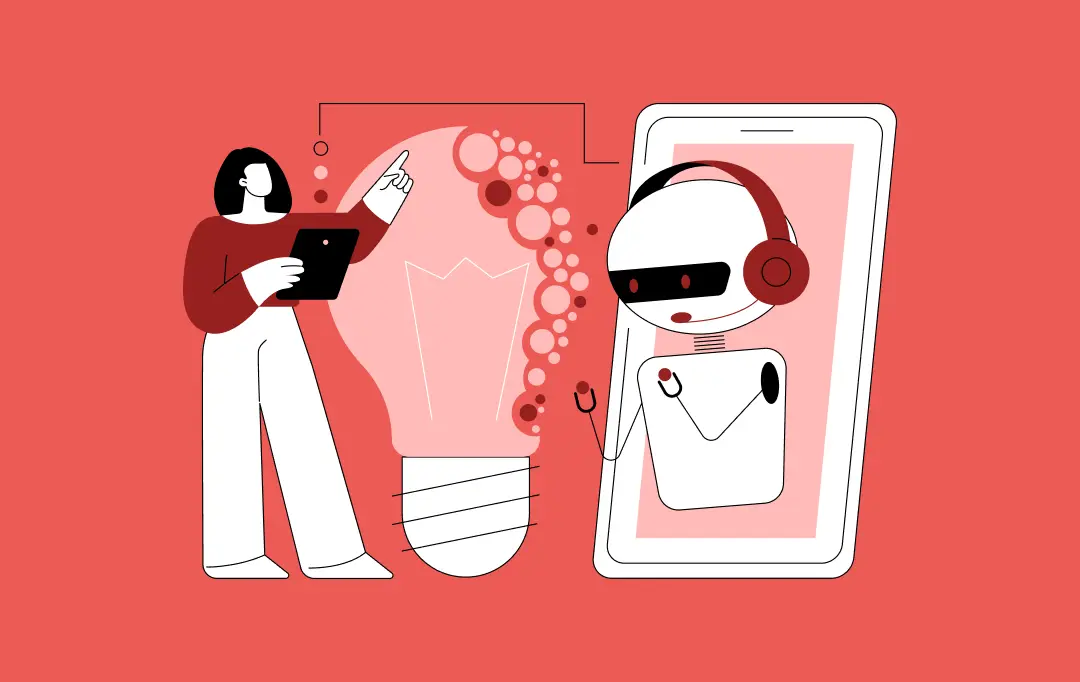
How Much Does It Cost to Build an AI App in Dubai?
Key takeaways: AI app costs in Dubai typically range from AED 80,000 for simple builds to AED 800,000+ for enterprise systems. Dubai is past AI experimentation, and not investing now means catching up later at higher cost. The real budget is driven by data, integrations, architecture, and compliance, not just app features. Hidden costs like…
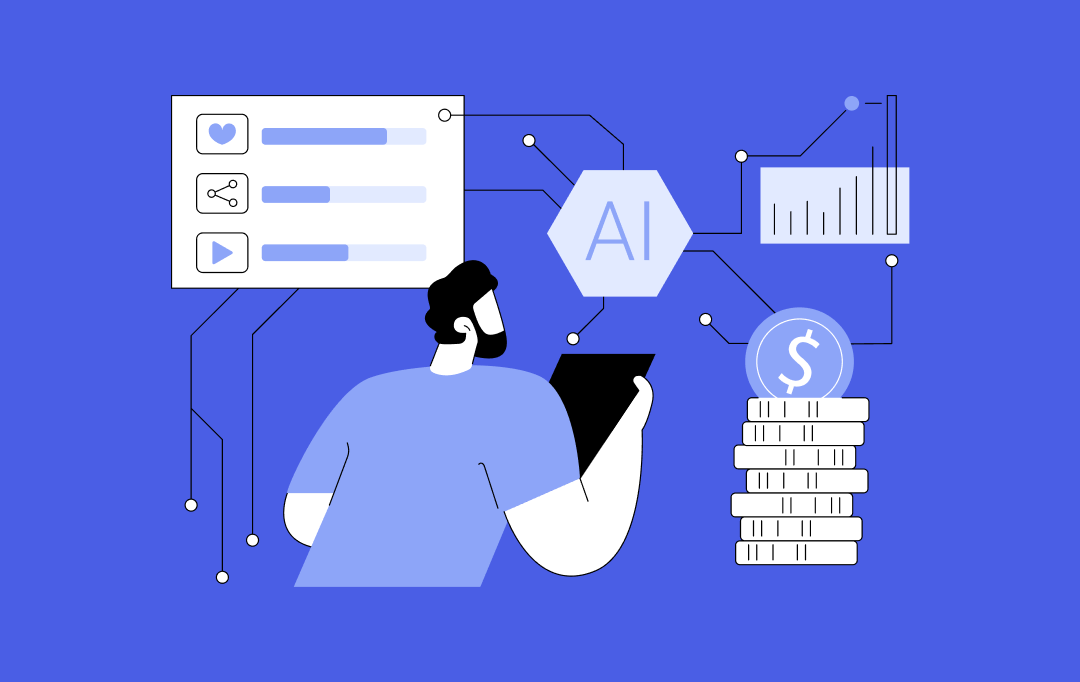
How AI Tokenization is Enabling Secure and Transparent Asset Ownership in 2026
By 2026, AI tokenization has moved beyond early-stage experiments and pilot projects. Tokenizing real-world assets has become a serious commercial strategy for financial institutions, supply chain operators and technology-driven enterprises. A 2025 report by the World Economic Forum in collaboration with Accenture highlights tokenization as a key mechanism for value exchange in modern financial markets.…
